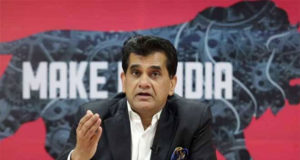
The 1983 batch IAS officer of Bihar cadre, C. K. Mishra, Secretary in the Ministry of Health & Family Welfare has been appointed as Secretary, Ministry of Environment, Forests & Climate Change (MoEF & CC). He has been known to usher in new healthcare initiatives as additional secretary health in the past and has been assigned the new role because of his competencies and dynamicity. Government has assigned him the Environment department, because he will be able to take forward new set of initiatives in Environment sector which will deliver favourable outcomes holistically for public health. In an interview with Healthy India Chronicle, he shares various initiatives in the healthcare sector under his mentorship.
Q1. What is your perspective on new National Health Policy (NHP) of the Narendra Modi government. It aims at raising public health expenditure to 2.5 per cent of the GDP (from the current 1.3 per cent) and envisages private sector collaboration in a big way?
Q2. How is NHP 2017 different from earlier health policies?
Launched after a period of 15 years, the new health Policy aims for the highest possible level of good health and well-being through a preventive and promotive health care orientation in all developmental policies, and to achieve universal access to good quality health care services without anyone having to face financial hardship as a consequence. Salient differentiating features are:
- a) Elaborate participatory process of designing the Policy. Wide ranging consultations with multiple stakeholders including government ministries, departments, civil society, academia, service users and care givers were done to draft the Policy after which it was in public domain for a significant period of time before being finalized.
- b) Universal healthcare approaches i.e. shift of focus from sick-care to overall wellbeing.
- c) The Policy commits to 2.5% of GDP to healthcare in a phased manner.
Q3. What are your plans for free universal primary care and the way forward for private sector coming in as a partner for strategic gap-filling.?
Through our new National Health Policy 2017 we envisage providing larger package of assured comprehensive primary health care through the ‘Health and Wellness Centers’ i.e. a comprehensive primary health care package which includes geriatric health care, palliative care and rehabilitative care services. In order to provide access and financial protection at secondary and tertiary care levels, NHP 2017 proposes free drugs, free diagnostics and free emergency care services in all public hospitals.
The Policy envisages strategic purchase of secondary and tertiary care services as a short term measure to supplement and fill critical gaps in the public health system, here short-term being the key word.
Q4. What are the timelines and plans for universal disease screening, which will be launched this year?
To tackle the Non Communicable Diseases (NCDs), we plan to transform 1.5 lakh Sub centers across the country to ‘wellness centers’ to screen the NCDs including screening for three cancers viz. cervix, breast and oral cancer. In the first phase, the population based screening component will be rolled out in 100 districts in 32 states and UTs with about 1000 sub-centres undertaking screening this year.
Q5. What are the plans to bring in reforms in medical education as well as regulatory reforms?
We manage medical education through PMSSY wherein not only do we construct medical colleges, we also are increasing the number of graduate as well as post graduate seats. As on date (2017-18) total MBBS seats stand at 67352 (2169 increase over 2016-17) and total PG seats (including PG & DNB) stand at 36967 (6043 increase over 2016-17).
As regards regulation, to ensure good practice, ensuring dignity of service for certain specific conditions, for providing legal sanctity and right to the patients the Ministry has brought out several health acts and bills viz. the most recent HIV/AIDS Act 2017, the Surrogacy Bill, Mental health Act with stress on strict action against the violators. We also have the PC-PNDT Act to regulate the usage of ultrasound machines. Besides the existing CEA (Clinical Establishment Act), in the National Health Policy-2017 we have a special section to ensure regulation i.e.
- a) The Policy recognizes the need to regulate the use of medical devices so as to ensure safety and quality compliance as per the standard norms.
- b) The Policy recommends Post market surveillance program for drugs, blood products and medical devices shall be strengthened.
- c) Focus on clinical safety and well-being of clinical trial participants.
- d) Timely revision of National List of Essential Medicines along with appropriate price control for generic drugs.
- e) Regulate the use of medical devices so as to ensure safety and quality compliance as per the standard norms.
- f) Standard Regulatory framework for laboratories and imaging centers, specialized emerging services such as assisted reproductive techniques, surrogacy, stem cell banking, organ and tissue transplantation and Nano Medicine will be created as appropriate.
Q6. How much should you get as budgetary allocation if you go by the target?
Health needs increased investments. Last few years have proven the point that whenever we have increased public spend on health, the results have been encouraging. The improvements in Maternal and Child Health parameters are a proof of this. Centre and States need to keep increasing investment in health, particularly, primary health.
Q7. What are plans about digital inclusion in a big way. Is there any promising pilot?
There is multitude of digital initiatives by MoHFW. In-fact our health pavilion in IITF last year was all about digital health. As of now, our most successful and significant digital initiatives are the eVin and MCTS and the most promising pilot is the ANMOL – ANM online.
Q8. What are the best practices and innovations that you are doing?
An annual best practices summit is held each year as a way to promote and applaud states towards innovations and unique solutions to healthcare challenges. This year it was held at Indore in July. We published a book which lists out all best practices and innovation. However, what immediately comes to mind is how Chattisgarh has devised strategies to retain Human Resources in the Left Wing Extremist areas or how Gujarat conducts the ‘Swachata Mission Audit’ of its public facilities. At national level, I feel up-gradation of our sub centers to wellness centers for screening the NCDs is a big innovation towards managing the growing burden of NCDs in the country.
Q9. What is the status of National Health Mission, which involves 60:40 sharing (between the Centre and states)?
NHM is one of the flagship programs and has helped us achieve health targets through health system strengthening.. I need to clarify that funding under NHM is not just 60:40, its different as per State needs 60:40 – Normal States, 90:10 – North East and Himalyan States and 100% for the UTs. Now to give you a brief snapshot of NHM progress-
Strengthening the Infrastructure:
- a) During the last 3 years (March, 2014 – 2015 – March, 2016-2017), 4, 730 new constructions and 8,509 renovations of health facilities including SC, PHC, CHC, SDH and DH were sanctioned, whereas 7904 constructions and 11,097 renovations have been completed.
- b) Accredited Social Health Activists (ASHAs): 60,127 ASHAs have been selected in the entire country and 76,486 provided with health kits.
- c) Augmentation of Human Resources: Nearly 21,234 additional health human resources have been added under NRHM.
- d) Mainstreaming of AYUSH: 7859 AYUSH doctors have been engaged under NHM.
- e) Emergency Response Service (ERS): 3003 vehicles supporting Dial 102/104 services and 1427 vehicles supporting Dial 108 services were operationalized.
- f) Community participation: 2.86 Crore Village Health and Nutrition Days (VHND) were held under NRHM.
- g) Dialysis programme – Where more than 300 districts are doing an excellent job.
- h) The Mission has brought about sharp reduction in Maternal and Child Mortality, contributed largely to reduction in Communicable diseases and now is increasing investment to tackle non-communicable diseases.
Q10. The healthcare Policy talks about increasing health care spending to 2.5 per cent of the GDP. Does it mean massive private linkages?
I have answered this above, however once again I will say that it does not solely mean private linkage; proof from the fact that the union budget 2017-18 gave 27.7% increased allocation to MoHFW over the 2016-17 budget. While this is a huge step forward, we need to also tap resources of the private sector.
Q11. How do you plan to reduce costs considering India’s out-of-pocket expenditure is very high at 58 per cent. Of this, 70 per cent is spent on drugs and diagnostics.
- a) Under NHM, Free Drug Service Initiative and the NHM Free Diagnostic Service Initiative to provide essential drugs and diagnostics free of cost in government facilities is rolled out to provide these services absolutely free of cost at all government facilities, drugs/ diagnostics from a major part of the out of pocket expenditure.
- b) The cost of dialysis services is about Rs 3 lakhs annually in the private sector and most patients are unable to afford dialysis care. The Ministry has rolled out the Pradhan Mantri National Dialysis Programme under which support under NHM is being provided to all States for provision of free dialysis services for the poor. In 2016-17, approval was issued for 519 District Hospitals (DHs). So far, 1,069 Dialysis Units and 2,319 Dialysis Machines have been made operational from which 1.43 lakhs patients have availed of the services. Also, nearly 17 lakhs dialysis sessions have been conducted.
- c) The PM Jan Aushadhi Scheme and AMRIT stores initiative have been rolled out to provide quality drugs at affordable prices. 102 AMRIT stores are functional across the country.
- d) The universal screening and management programme for common NCDs of hypertension, diabetes, three common cancers and the chronic pulmonary disease will go a long way in reducing premature morbidity and mortality on account of NCDs, and its related costs.
- e) To address concerns on cost and quality of care in private sector, the states have been advised to implement Clinical Establishment Act as appropriate to their context precises of critical item have been capped.
Q12. What are the plans to ensure generic prescription. Is it being done?
The Ministry recently issued a draft gazette notification making it mandatory for pharma companies to carry generic name of drugs on packs that is at least two fonts larger than the brand name. This clause will be a legal provision as a rule under the existing Drugs and Cosmetics Act and any violation will be punishable under the provisions of the law. The Ministry has sought public comments on the draft, after which it is likely to become part of the drug law.
We have also asked the Medical Council of India (MCI), state governments and all central government hospitals asking them to ensure that doctors write prescriptions with generic names of medicines in a legible hand writing.
























